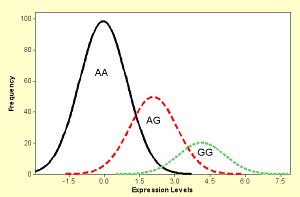Using Maps to Find Managers
 Through the Human Genome Project, the HapMap Project and other efforts, we are beginning to identify genes that are modified in some diseases. What are more difficult to measure and identify are the regulatory regions in DNA – the ‘managers’ of genes – that control gene activity and might be important in causing disease.
Through the Human Genome Project, the HapMap Project and other efforts, we are beginning to identify genes that are modified in some diseases. What are more difficult to measure and identify are the regulatory regions in DNA – the ‘managers’ of genes – that control gene activity and might be important in causing disease.
Today, a team led by the Wellcome Trust Sanger Institute, together with colleagues in the USA and Switzerland, provide a measure of just how important regulatory region variation might be in a pilot study based on some 2 per cent of the human genome. As many as 40 of 374 genes showed alteration in genetic activity that could be related to changes in DNA sequence called SNPs.
Founded on the Human Genome Project and HapMap Project, this new work highlights how much we still have to learn about DNA sequence variation and disease.
“We were amazed at the power of this study to detect associations between SNP variations and gene activity. We were even more amazed at the number of genes affected: more than 10 per cent of our sample – or perhaps 3000 genes across the genome – could be subject to modification of activity in human populations due to common genetic variations. This would be a remarkable new source of understanding.”
Dr Manolis Dermitzakis Investigator, Division of Informatics at the Wellcome Trust Sanger Institute
The study combined the map of genetic variation developed through the HapMap with estimates of gene activity obtained from cell cultures from 60 individuals who provided samples for the HapMap. More than 630 genes were studied, of which 374 were active in the cell cultures. If gene activity in a cell culture was skewed from the average, it was investigated further.
These genes were correlated with more than 750,000 SNPs – sequence differences between individuals in the sample collection. A series of statistical tests were carried out to provide increased confidence in the association between gene activity and sequence variation.
“Our sample size of 60 individuals is relatively small and we might expect not to detect rare variations. However, our pilot project gives us greater confidence to take on a genome-wide survey of gene activity.”
Dr Manolis Dermitzakis Sanger Institute
A global map linking sequence variation and gene activity will be an important tool in the interpretation of variation and disease. Such genome-wide association studies will be able to identify some regions of the genome with strong disease effects.
“HapMap has generated a comprehensive chart of common sequence variation in human populations. Correlating this information to functional data will further empower our ability to identify the genetic variants underlying common diseases and other complex traits.”
Dr Panos Deloukas Senior Investigator, Division of Medical Genetics, Wellcome Trust Sanger Institute
The project focused on three regions of the human genome. The first, called the ENCODE regions, and about 30 million base-pairs of DNA, are being intensively studied around the world as a group of ‘typical’ human genome regions. The second was 35 million base-pairs of chromosome 21 sequence: three copies of chromosome 21 lead to Down Syndrome. The third was a region of chromosome 20-10 million base-pairs – that is known to be associated with diabetes and obesity.
In comparison with gene sequences that contain the instructions to make proteins, regulatory regions that control genes are relatively poorly understood. Their structure is variable and their distance from the genes they control also varies among genes.
New tools are needed in the search of our genome for the sequences that contribute to disease, tools that will harness the massive amounts of DNA information and transform them into information of real biomedical utility. The methods described here, with the power of the HapMap data and the cell cultures available, will speed that transformation.
More information
Participating Centres
- Wellcome Trust Sanger Institute, Wellcome Trust Genome Campus, Hinxton, UK
- Department of Molecular Biology and Genetics, Cornell University, Ithaca, USA
- Department of Genetic Medicine and Development, University of Geneva Medical School, Geneva, Switzerland Illumina, Inc., San Diego, CA, USA
- Department of Oncology, University of Cambridge, Hutchison/MRC Research Centre, Hills Road, Cambridge CB2 2XZ, UK
- Program in Molecular and Computational Biology, University of Southern California, Los Angeles, CA 90089-2910
Publications:
Selected websites
The Wellcome Trust Sanger Institute
The Wellcome Trust Sanger Institute, which receives the majority of its funding from the Wellcome Trust, was founded in 1992. The Institute is responsible for the completion of the sequence of approximately one-third of the human genome as well as genomes of model organisms and more than 90 pathogen genomes. In October 2006, new funding was awarded by the Wellcome Trust to exploit the wealth of genome data now available to answer important questions about health and disease.
The Wellcome Trust and Its Founder
The Wellcome Trust is the most diverse biomedical research charity in the world, spending about £450 million every year both in the UK and internationally to support and promote research that will improve the health of humans and animals. The Trust was established under the will of Sir Henry Wellcome, and is funded from a private endowment, which is managed with long-term stability and growth in mind.


